Notes
- ↑ "Water Supply Projects". NESPAK. Archived from the original on 13 April 2012. Retrieved 5 July 2012.
| Burj Aziz Khan Dam | |
|---|---|
| Country | Pakistan |
| Location | Balochistan |
| Status | In use |
| Construction cost | $291 million |
| Owner(s) | Government of Balochistan |
Burj Aziz Khan Dam is located near Quetta in Balochistan, Pakistan. It was constructed at a cost of $291 million [1] to supply water to Quetta.

Balochistan is a province of Pakistan. Located in the southwestern region of the country, Balochistan is the largest province of Pakistan by land area but is the least populated one. It is bordered by the Pakistani provinces of Khyber Pakhtunkhwa to the north-east, Punjab to the east and Sindh to the south-east; shares international borders with Iran to the west and Afghanistan to the north; and is bound by the Arabian Sea to the south. Balochistan is an extensive plateau of rough terrain divided into basins by ranges of sufficient heights and ruggedness. It has the world's largest deep sea port, the Port of Gwadar lying in the Arabian Sea.
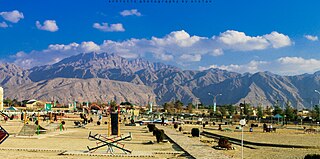
Quetta is the capital and largest city of the Pakistani province of Balochistan. It is the tenth largest city in Pakistan, with a population of over 1.1 million. It is situated in the south-west of the country, lying in a valley surrounded by mountains on all sides. Quetta is at an average elevation of 1,680 metres above sea level, making it Pakistan's only high-altitude major city. The city is known as the "Fruit Garden of Pakistan" due to the numerous fruit orchards in and around it and the large variety of fruits and dried fruits produced there.
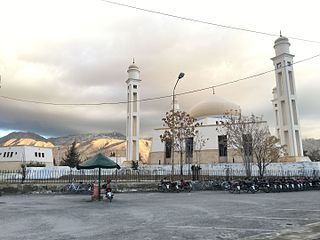
Quetta is a district in the north-west of the Balochistan province of Pakistan, on the border with Kandahar province, Afghanistan. It is part of Quetta Division. The district is famous for its agriculture produce, most notably fruit orchards but also including apples and grapes. The Hanna Valley is an area where almonds are grown. The population counted in the 1998 census was 760,000, while in 2010 it was estimated at 1,235,000.

The Mangla Dam is a multipurpose dam situated on the Jhelum River in the Mirpur District of Azad Kashmir, Pakistan. It is the sixth-largest dam in the world. The village of Mangla, which sits at the mouth of the dam, serves as its namesake. In November 1961, the project's selected contractors were revealed; it was announced that Binnie & Partners, a British engineering firm, was going to serve as the lead designers, engineers, and inspectors for the construction of the dam. The project was undertaken by a consortium known as the Mangla Dam Contractors, which consisted of eight American construction firms sponsored by the Guy F. Atkinson Company based in South San Francisco, California.

Hub Dam is a reservoir on the Hub River. It is situated 56 km from Karachi city in Karachi and Hub District on Sindh and Balochistan provinces border. The dam is extended to 24300 acres with gross storage capacity of 857000 acre feet. It is Pakistan's fifth-largest dam. It is an important source that provides the drinking water to the metropolitan city Karachi.

Zhob, formerly known as Appozai, is a city and district headquarters of the Zhob District in the Balochistan province of Pakistan. Zhob is located on the banks of the Zhob river. It is 337 kilometres away from Quetta, the capital of Balochistan.
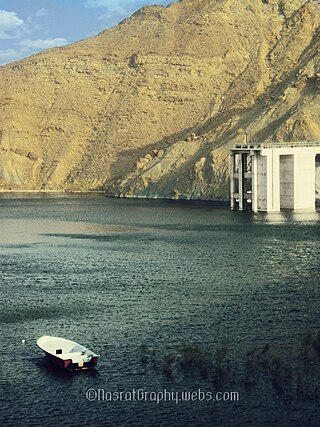
Miraani Dam. Dasht River south of the Central Makran Range in Kech District in Balochistan province of Pakistan. Its 302,000 acre-feet (373,000,000 m3) reservoir is fed by the Kech River and the Nihing River. Mirani Dam was completed in July 2006 and began impounding the Dasht River in August 2006.
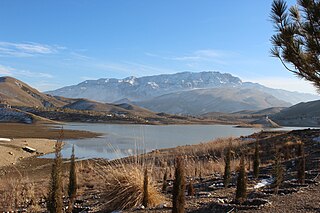
Hanna Lake is a lake in Urak Valley near Quetta, in Balochistan Province, in southwestern Pakistan. It is surrounded by mountains.
Drinking water supply and sanitation in Pakistan is characterized by some achievements and many challenges. In 2020, 68% Pakistanis, 72% Indians, 54% Bangladeshi had access to the basic sanitation facilities. Despite high population growth the country has increased the share of the population with access to an improved water source from 85% in 1990 to 92% in 2010, although this does not necessarily mean that the water from these sources is safe to drink. The share with access to improved sanitation increased from 27% to 38% during the same period, according to the Joint Monitoring Program for Water Supply and Sanitation. There has also been considerable innovation at the grass-root level, in particular concerning sanitation. The Orangi Pilot Project in Karachi and community-led total sanitation in rural areas are two examples of such innovation.

The Pakistan Water & Power Development Authority is a government-owned public utility maintaining power and water in Pakistan, although it does not manage thermal power. WAPDA includes Tarbela and Mangla dams among its resources. Its headquarters are in Lahore.
Afghan-India Friendship Dam (AIFD), formerly Salma Dam, is a hydroelectric and irrigation dam project located on the Hari River in Chishti Sharif District of Herat Province in western Afghanistan. The Afghan cabinet had renamed the Salma Dam to the Afghan-India Friendship Dam to express gratitude to India, which funded and helped with completing the partially constructed project.
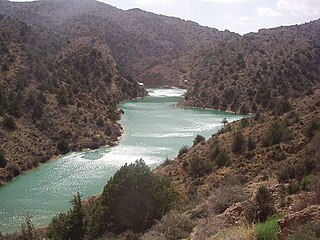
Wali Tangi Dam is a small dam in the Urak Valley in Balochistan province of Pakistan. It is situated approximately 20 km east of Quetta at an elevation of approximately 8,350 ft.

The topography of Pakistan is divided into seven geographic areas: the northern highlands, the Indus River plain, the desert areas, the Pothohar Plateau, Balochistan Plateau, Salt Range, and the Sistan Basin. All the rivers of Pakistan, i.e. Sindh, Ravi River, Chenab River, Jhelum River, and Sutlej River, originate from the Himalayas mountain range. Some geographers designate Plateau as to the west of the imaginary southwest line; and the Indus Plain lies to the east of that line.

The economy of Balochistan, one of the four provinces of Pakistan, is largely based upon the production of natural gas, coal, and minerals. Agriculture and livestock also dominate the Baloch economy. Horticultural development is a fairly recent, yet growing phenomenon. Other important economic sectors include fisheries, mining, manufacturing industries, trade and other services being rendered by public and private sector organizations in the province.

The Pakistan Canoe and Kayak Federation (PCKF) is the official national governing body for canoeing and kayaking Olympic sports in Pakistan. Its function is to promote sporting activities and events for canoe and kayak paddlers across the country on a national and international level. PCKF is a non-profit organisation, which represents all people and organisations with a genuine interest in canoeing, kayaking and associated sports, helping them to increase the profile of these sports across Pakistan.
Akra Kaur Dam, sometimes also referred to as Ankara Kaur Dam, is located near Gawadar in Balochistan, Pakistan. The dam was constructed in 1995 at a cost of $24 million to supply water to Gawadar and adjoining villages. It is the sole source of water supply to residents of the Gwadar District area. The dam stretches over an area of 17,000 acres.
Mangi Dam is located near Ziarat in Balochistan, Pakistan. The dam was constructed in 1982 and has a height of 18 m (59 ft) and storage capacity of 130,000 m3 (105 acre⋅ft). It was constructed at a cost of US$36.88 million. It was made to stop the fish from leaving the fishing area. In 2015 it is announced that the dam will also produce electricity and the shortage of load shedding will also reduce.
On 16 February 2013, at least 91 people were killed and 190 injured after a bomb hidden in a water tank exploded at a market in Hazara Town on the outskirts of Quetta, the capital city of Balochistan, Pakistan. Most of the victims were members of the predominantly Shia Twelver ethnic Hazara community, and authorities expected the death toll to rise due to the large number of serious injuries. The Lashkar-e-Jhangvi group claimed responsibility for the blast, the second major attack against the Shia Hazaras in a month.

Nai Gaj Dam is an embankment dam currently under construction on the Gaj River in the gorge area at the edge of Kirthar Mountains range at about 65 kilometres (40 mi) north-west of Dadu city in Dadu District, Sindh Province of Pakistan. When complete, its power station will have a 4.2 MW installed capacity. Consultant supervision by Techno Consult International (TCI) from Karachi, Pakistan.

The 2015 Quetta bus bombing occurred on 19 October 2015 in Quetta a city in Balochistan. The blast killed at least 11 people and another 22 were injured.